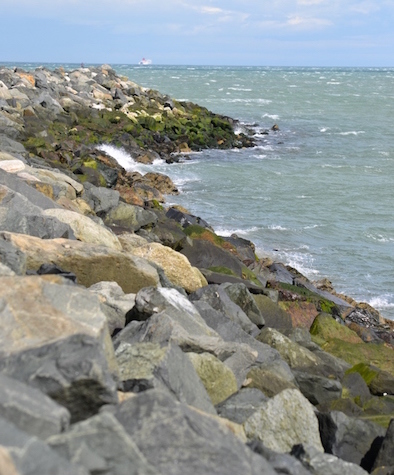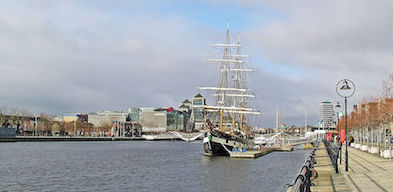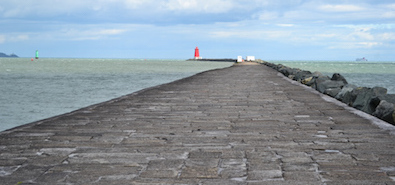Threemaster
Threemaster
In Brief
At the end of Proteus Stephen looks back over his shoulder and sees the masts of a sailing ship floating into Dublin on the flood tide: "Moving through the air high spars of a threemaster, her sails brailed up on the crosstrees, homing, upstream, silently moving, a silent ship."
Read More
Several aspects of this occurrence require comment. First, it is helpful to visualize where Stephen is and to realize exactly what he must be seeing. He is sitting on the seaward side of the South Wall, the long breakwater that separates the waters of the River Liffey on the north from the tide flats on the south. With high tide approaching, seawater is flowing in along the extended channel of the Liffey, facilitating the ship's approach to the Dublin docks. Its sails are furled on the yardarms because it is taking advantage of the tide.
The seaward side of the wall is buttressed by massive granite blocks, which tumble some distance down to the water. Stephen must be sitting near the bottom of the wall of rocks, because, as he watched the tide approaching the seawall a short while earlier, he thought, "My ashplant will float away." His location at the bottom of the wall accounts for the language of the narration, which says that the "spars" of a ship are "Moving through the air." The body of the ship is apparently obscured by the wall of rock, meaning that Stephen sees a kind of surreal apparition: three masts with "crosstrees" hovering in the air, moving slowly to his left. This spectral appearance evokes the timeless, symbolic image of the three crosses at Calvary.
But the ship is quite real. Joyce tells his reader nothing about it at this point, but later chapters will fill in some blanks. In Wandering Rocks, the throwaway that Bloom has thrown away into the Liffey floats "eastward by flanks of ships and trawlers, amid an archipelago of corks, beyond new Wapping street past Benson's ferry, and by the threemasted schooner Rosevean from Bridgwater with bricks." Why name only one schooner among all the ships? The fact that it is identified as a threemaster may encourage an observant reader to suppose that this may be the ship that arrived in Dublin a few hours earlier.
Eumaeus rewards this hypothetical reader with actionable information. In the cabman's shelter a grizzled sailor who calls himself D. B. Murphy says, "We come up this morning eleven o'clock. The threemaster Rosevean from Bridgwater with bricks." Since Stephen was sitting along the wall at some time around 11:00, it must have been this threemaster that he saw. And Gifford notes that a schooner of that name was indeed reported in the Freeman's Journal of 16 June 1904 as having arrived in Dublin "from Bridgwater with bricks." Bridgwater is in SW England, just west of Bristol. Gifford observes that "it was well known for its manufacture of Bath bricks (scouring bricks used to clean knives and polish metal)."


